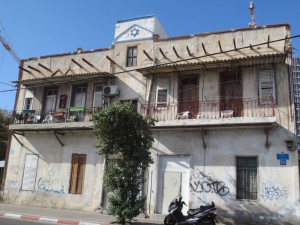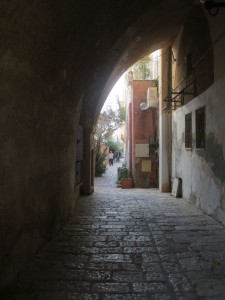Tel Aviv, Jaffa and the “vanished” villages
gennaio 24, 2014 in Palestina, Traduzioni da Anna Zorzi
Written by Sonia Trovato, translated by Anna Zorzi ![]()
 Tel Aviv, Charles Clore Park. A cute man, in his tight tank top which shows off his muscles , and a sexy young woman, pleasantly involved in the music from her headphones, are jogging. Do they happen to know they are running on a mound of rubble? As a matter of fact, this park, named after a tycoon belonging to the English Jewish community, has been built on the ruins of the Palestinian village of Al-Manshiyya, which was founded at the beginning of 1800 and razed to the ground in 1948. Al-Manshiyya is one of the many Palestinian villages which have been cancelled on the map and replaced by Jewish ones. Zochrot, which means “to remember”, is an Israeli association which acknowledges the Nakba, i.e. the mass expulsion of the Palestinians in 1948, and which struggles for the Palestinians’ right to get back their own land, according to a UN resolution. The figures you are informed about by the tour guide while being shown around on your way to Jaffa are astonishing : more than 800,000 people expelled from their land; 531 villages destroyed; 40,000 Palestinians killed during the ethnic cleansing operations. Of the 44% of Palestine officially given to the Palestinians after the UN resolution 181, a further 22% was grabbed by Israel after the war in 1967 and 60% of this part is occupied by the Israeli army and settlements. Mike’s family, your tour guide, belonged to one of those villages and was forced to leave it for Jerusalem, before it was transformed itself into a Jewish town.
Tel Aviv, Charles Clore Park. A cute man, in his tight tank top which shows off his muscles , and a sexy young woman, pleasantly involved in the music from her headphones, are jogging. Do they happen to know they are running on a mound of rubble? As a matter of fact, this park, named after a tycoon belonging to the English Jewish community, has been built on the ruins of the Palestinian village of Al-Manshiyya, which was founded at the beginning of 1800 and razed to the ground in 1948. Al-Manshiyya is one of the many Palestinian villages which have been cancelled on the map and replaced by Jewish ones. Zochrot, which means “to remember”, is an Israeli association which acknowledges the Nakba, i.e. the mass expulsion of the Palestinians in 1948, and which struggles for the Palestinians’ right to get back their own land, according to a UN resolution. The figures you are informed about by the tour guide while being shown around on your way to Jaffa are astonishing : more than 800,000 people expelled from their land; 531 villages destroyed; 40,000 Palestinians killed during the ethnic cleansing operations. Of the 44% of Palestine officially given to the Palestinians after the UN resolution 181, a further 22% was grabbed by Israel after the war in 1967 and 60% of this part is occupied by the Israeli army and settlements. Mike’s family, your tour guide, belonged to one of those villages and was forced to leave it for Jerusalem, before it was transformed itself into a Jewish town.
Once in Al-Manshiyya there was a library and a mosque.  The former has been destroyed, the latter is still miraculously existing only thanks to the care of the Palestinians, who are charged for the maintenance expenses. And yet this place, holy for the Muslims, is often the target of attacks or vandalism by the young Jewish. Other two buildings have survived the destructive power of bulldozers . The first is an old two-storey house with the big star of David on the top of the roof. Zochrot has made this place the emblem of the misappropriation of the originally Arabian lands. The second building houses a military museum, Etzel musem, named after the extreme-right wing Zionist group which terrorized the people under the British mandate. The plaque on the building wall shows the symbol of the movement: a rifle drawn on the map of Palestinian and Jordan territories and the worrying motto, “only this way”. You visitors feel frozen with shock. Behind the museum untidy rows of kitsch skyscrapers mark the skyline, in front of the museum the sea joins the horizon. But it’s an expressionless, rejecting sea dominated by a big warning sign: no swimming.
The former has been destroyed, the latter is still miraculously existing only thanks to the care of the Palestinians, who are charged for the maintenance expenses. And yet this place, holy for the Muslims, is often the target of attacks or vandalism by the young Jewish. Other two buildings have survived the destructive power of bulldozers . The first is an old two-storey house with the big star of David on the top of the roof. Zochrot has made this place the emblem of the misappropriation of the originally Arabian lands. The second building houses a military museum, Etzel musem, named after the extreme-right wing Zionist group which terrorized the people under the British mandate. The plaque on the building wall shows the symbol of the movement: a rifle drawn on the map of Palestinian and Jordan territories and the worrying motto, “only this way”. You visitors feel frozen with shock. Behind the museum untidy rows of kitsch skyscrapers mark the skyline, in front of the museum the sea joins the horizon. But it’s an expressionless, rejecting sea dominated by a big warning sign: no swimming.
While approaching Jaffa, you are told by the volunteers of Zochrot how Eztel occupied the town and how this military action is commemorated on the plaque of the museum as “ liberation”. Over 70,000 Palestinians were expelled by sea, to Beirut or Gaza, and forced to abandon the town, which up to 1948 was considered as the most important Palestinian port for the pilgrims to the Holy Land. Today the Arabs living in Jaffa are a quarter of its inhabitants and do their best by selling falafel and carpets to tourists, most of whom ignore that this town was one of the oldest in the West Bank and now it is reduced to be a suburb under the Tel Aviv administration. After these preliminary remarks, your visit to Jaffa can’t but be sour and unpleasant. We penetrated the narrow alleys of what once was a flourishing Arab old town and is now an ‘Israeli Artists’ Colony’ . How sensitive artists can sometimes be ! writes Suad Amiry in her irreverent Sharon and my mother – in- law. You walk around the town and yet you look forward to leaving it; the many signs boasting about the Jewish origins of the town displayed by the Israeli administration on landmarks increase your feeling of unease, as you know that this land was grabbed from its original inhabitants; even the amphitheatre disappoints you. Yalla – let’s go- says Mike and, much to our relief, we leave this cold, inhospitable town on a rainy day, ready to go to a house full of warmth, courage and freedom. On the threshold Samer Issawi, the partisan, is waiting to welcome us.







